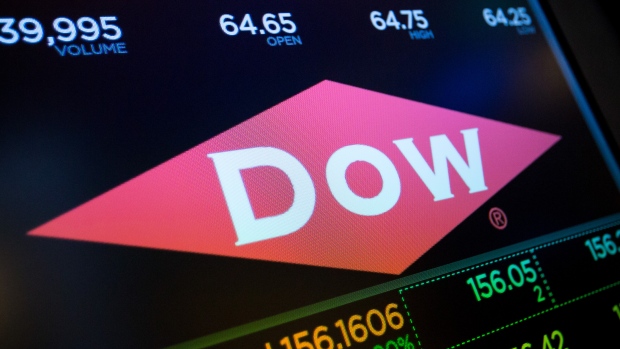Apr 2, 2019
Dow Inc. jumps in first trading day after split from DowDupont
, Bloomberg News

Dow Inc. jumped on its first day of trading as an independent chemical company as investors flocked to the lure of an industry-leading dividend.
Dow gained as much as 6.1 per cent compared with “when-issued” trading that preceded the distribution of the new stock. With its spinoff from DowDuPont Inc., Dow replaces its former parent in the Dow Jones Industrial Average, maintaining the index’s exposure to the materials sector, according to S&P Global Inc.
Dow Chief Executive Officer Jim Fitterling, 57, promises to spend less on new factories and return 65 per cent of net income to shareholders through stock buybacks and a hefty dividend. The new Dow is more focused than the one that merged with DuPont in 2015, having shed agriculture and other units in the process of winnowing 15 businesses down to six. Plastics and packaging now account for about half of revenue and earnings.
“Dow offers a compelling value opportunity,” Robert Koort, an analyst at Goldman Sachs Group Inc. said in a note Tuesday. “In addition to a promising cyclical positioning, we believe the transformation from ‘old Dow’ to ‘new Dow’ suggests more shareholder friendly capital allocation and a leaner more focused cost structure.”
Cyclical Low
Dow’s plastics business is approaching a cyclical low that is set to rebound in 2020, Koort said as he initiated the stock with a Street-high US$71 price target. The shares will pay a “best-in-class” dividend yield of about 5.6 per cent, he said.
Shares rose 5.4 per cent to US$56.40 as of 10:21 a.m. in New York.
Dow’s separation has been in the works since 2015 when Dow Chemical Co. and DuPont Co. agreed to merge, temporarily creating the world’s largest chemical company. The plan from the start was to redivide into three new companies focusing on commodities, agriculture and specialty products.
Dow’s near-term earnings outlook recently weakened. DowDuPont last week said Dow’s first-quarter earnings will drop by about US$100 million more than previously forecast, largely because of narrower plastics profit margins. Production in the U.S. is rising faster than the market can absorb mainstay resins like polyethylene, which is used in consumer packaging and bags.
Dow’s outlook also is clouded by trade tensions with China and a backlash against plastic waste that’s prompted a global wave of bans on bags and other single-use plastics, eroding some the industry’s historical growth. Still, the company aims to increase earnings as much as 30 per cent in the next few years through targeted investments and cost cuts.
The final step in DowDuPont’s breakup comes June 1 when it peels off the agriculture division, to be named Corteva Inc., leaving DuPont as a stand-alone company.


